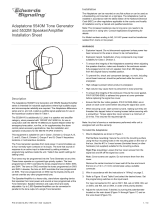Page is loading ...

© 2015 UTC Fire & Security. All rights reserved. 1 / 2 P/N 3100796-EN • REV 04 • ISS 16JAN15
5522M and 5523M Duotronic
Signal Installation Sheet
Description
The 5522M and 5523M Duotronic Signals are high decibel signaling
appliances intended for indoor use where distinctive audible signals
are required in hazardous locations. The 5522M series are horns and
the 5523M series are sirens. The units are rated at an average 110 dB.
The 5522M and 5523M series are UL and cUL listed for use in the
hazardous locations shown in Table 2.
The flange bolts of all series of the signals are sealed in accordance
with UL requirements to prevent disassembly and tampering.
This equipment is suitable for use in Class I, Division 1, Groups B, C,
and D; Class I, Division 2, Groups A, B, C, and D hazardous locations
for General Signaling Service.
Installation
Install and wire this device in accordance with applicable national and
local codes, ordinances, and regulations, and in a manner acceptable
to the local authority having jurisdiction.
When the device is used in general signaling applications, you must
install it in accordance with these instructions, and with the applicable
requirements of NFPA 70 in the US or CSA C22.1 in Canada.
When the device is used in Division 2 applications, you must install it in
accordance with the NFPA 70 Article 501-4b.
WARNINGS
• Explosion hazard. Do not disconnect equipment unless power has
been removed or the area is known to be nonhazardous.
• Explosion hazard. Substitution of any components may impair
suitability for Class I, Division 2.
• Explosion hazard. Do not disconnect equipment while the circuit is
live or unless the area is known to be free of ignitable
concentrations.
• To prevent fire, shock and component damage, no work, including
circuit board removal, should be performed while the circuit is
energized.
To install the signal:
1. Choose the mounting location. The horn or siren can be mounted
on any solid surface. Ensure that the mounting location provides
adequate clearance to enable adjustment of the signal to the
desired position after mounting. The signal position can be
adjusted within an approximate 180-degree range vertically or
horizontally depending on the mounting of bracket.
2. Mount the unit in the selected location using its mounting bracket
and three bolts (not supplied). See Figure 1 for the unit size and
the location of mounting holes.
3. Adjust the signal direction as desired, by loosening the two bolts
shown in Figure 1. Rotate the signal to the desired position, and
then tighten the bolts.
4. Wire the unit as shown in Figure 2
a. Remove cover from the conduit outlet box (not supplied). Note
that the outlet box must be suitable for use in the hazardous
location.
b. Feed the two power supply wires through the 1/2 in. NPT
conduit (not supplied) into the outlet box.
c. Feed the signal's two power connection wires either directly
into the outlet box or, if desired, through a 1/2 in. flexible type
coupling (not supplied) and then into box.
WARNING: Do not apply power to the unit until installation is
completed and the housing cover and outlet box cover are
secured.
d. Secure the outlet box to the signal's 1/2 - 14 NPT sealed
nipple either directly or by flexible coupling, and then secure
the conduit to outlet box.
e. Connect the power supply wires using two wire nuts (not
supplied). Polarity need not be observed when making
connections for a DC voltage source.
5. Replace the cover securely on the conduit outlet box.
6. Apply power to the signal and verify that it sounds correctly.
Figure 1: Signal dimensions and mounting details
(1) 1/2 in. (13 mm) mounting holes (3X)
(2) Bolts for adjusting signal direction (2X)
11-1/4 in.
(285 mm)
11-1/4 in.
(285 mm)
5 in. (127 mm)
2-1/2 in. (63 mm)
(1)
(2)
18-3/8 in.
(466 mm)

2 / 2 P/N 3100796-EN • REV 04 • ISS 16JAN15
Figure 2: Wiring installation and connections
(1) Power supply wires from selected AC or DC voltage source for
signal (2X)
(2) 1/2 in. NPT conduit (not supplied) attached to outlet box
(3) Outlet box suitable to hazardous location
(4) Green wire for earth ground
(5) 1/2 - 14 NPT nipple (not supplied)
(6) Adaptatone signal
(7) Power connection wires from signal (2X)
(8) Wire nuts (not supplied)
(9) To earth ground
Maintenance and testing
Examine the unit semi-annually for external accumulation of dirt. Clean
if necessary.
Test the signal monthly or at the intervals required by applicable
regulations and codes.
Specifications
Voltage
Refer to Table 1
Current
Refer to Table 1
Weight
18.4 lb. (8.4 kg)
Hazardous locations [1]
Ambient temp. −31 to 104°F (−35 to +40°C)
Nonhazardous locations
Variable ambient temp. −40 to 151°F (−40 to +66°C)
[1] Hazardous locations and variable ambient conditions apply only
where UL Listings are accepted.
Table 1: Input power
Model
Voltage Current (A)
5522M
-AQ
5523M
-AQ
24 VDC 0.32
24 VAC 50/60 Hz 0.95
5522M
-Y6
5523M
-Y6
125 VDC 0.130
250 VDC 0.130
120 VAC 50/60 Hz 0.260
240 VAC 50/60 Hz 0.260
Table 2: Hazardous locations
Model number
Hazardous location
Temperature code
5522M
-AQ
5522M
-Y6
5523M
-AQ
5523M
-Y6
Class I, Div. 1, Groups B, C,
and D
Class I, Div. 2, Groups A, B,
C, D
T5 (100°C, 212°F)
Regulatory information
Ratings
ANSI/ISA 12.12.01
CAN/CSA C22.2 No. 30
CAN/CSA C22.2 No. 205
UL 464
UL 1203
UL 1480
Contact information
For contact information, see www.edwardssignaling.com.
(1)
(9)
(6)
(5)
(2)
(3) (4)
(7)
(8)
/

